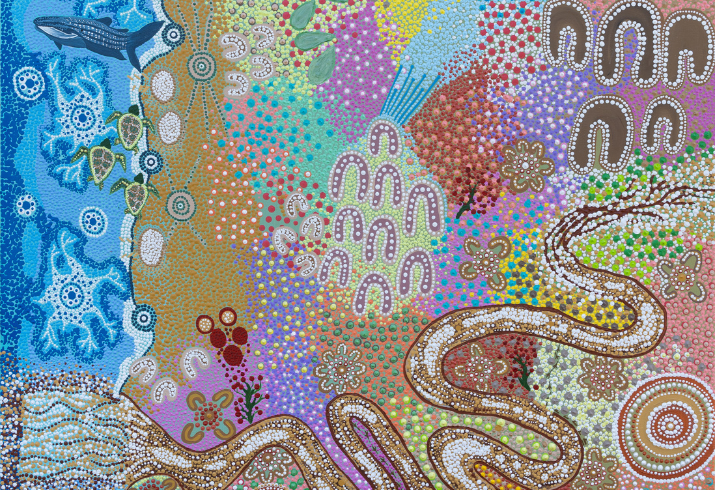Ugarla nganhu buujungga nyinamarda by Leeann Kelly-Pedersen
 “Ugarla nganhu buujungga nyinamarda” (long time ago we lived in the bush) by artist Leeann Kelly-Pedersen
“Ugarla nganhu buujungga nyinamarda” (long time ago we lived in the bush) by artist Leeann Kelly-Pedersen
Artist statement
This painting is about the magnificent breath-taking lands of the Gascoyne and the local Aboriginal tribes that inhabit this region, cultural connections with the land and the waters of the Gascoyne River and Indian Ocean.
It starts in the outback from Mount Augustus and spreads to the ocean. Mount Augustus is called “Burringurrah” to the local Wajarri people of the Burringurrah Aboriginal Community. In the Dreamtime there was a young boy who was speared and turned into a rock which is Mount Augustus. Some say they can see the shape of the rock looking like the boy laying down.
On these lands you can find bush-tucker along the way from Burringurrah to Carnarvon. Two of the most common bushtucker plants is the Quondong (“Warlgu” in Wajarri language) which is a bush fruit that comes out in summer, this is the time the fruit ripens. When cooked, it tastes like rhubarb.
The Bush Pears (“Gargula or cogla” in Wajarri language) is another bush fruit which grows on a vine that attaches itself to a tree. The smaller they are, the sweeter. They are described like corn. You eat the green parts inside.
Aboriginal people also track the emu to find his nest when it’s “emu egg season”. We tell by the “emu in the sky” (you can see the “emu in the sky” in the milky way) when its emu egg season. After the female lay the eggs, the male looks after them and the babies when they hatch. We don’t take them all, we always leave a few so the cycle begins all over again. Kangaroo is a very common type of bushtucker which is the main meat to eat for Aboriginal people.
These lands are covered in a carpet of wildflowers when the season comes around and as far as I can remember, the only seasons that we ever used and that I have heard while in my childhood was the cold season which was called Wanda, and the hot season called Garla. The word Garla is also used by the Wajarri people for Hot or Fire. The ground would be covered in pink, white, yellow ugudungu (everlastings).
The yellow everlasting is called the miruguru ( pronounced mir-oo-goo-roo). The yellow pom-poms are called the birriny-birriny (pronounced bid-inj-bid-inj). I remember there were also these big flat orange flowers that grew at the same time – we called them belly buttons. We used to walk through the belly buttons and the birriny-birriny and kick them catching one of them between our toes. The belly buttons were easy to catch between the toes because the flower was flat on top. They made our feet look beautiful, like a decoration for our feet. We never wore shoes walking around in the bush.
When it rains, a lot of the water flows from the high lands into the Gascoyne River and dumps it out of the river mouth into the ocean. Gascoyne River flowing into the Indian Ocean meets its salty partner. They swirl in harmony and celebration. The brown water is joined by the blue waters of the Indian Ocean. The beaches were common ground for the old people before us where they fished and left shell middens.
When the river is dry, it is not what it seems, as the water is sitting underground. The serpent is moving through the water underground, keeping the river in shape. Aboriginal people welcome the serpent with thanks and pay their respect by throwing a handful of sand into the river before entering for a swim. The Gascoyne River was home to many Aboriginal families with camps set up all along the riverbanks.

